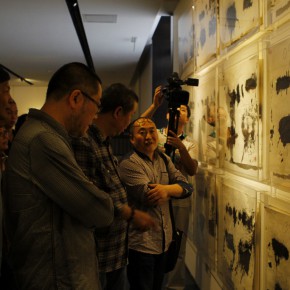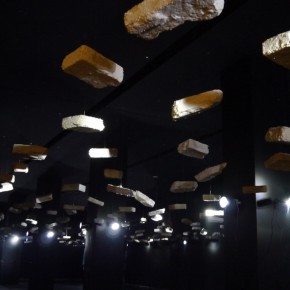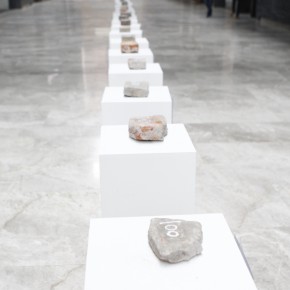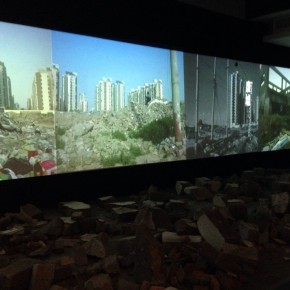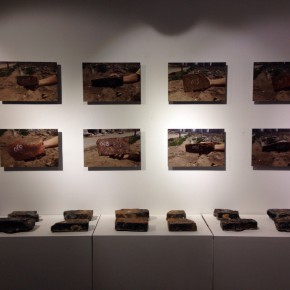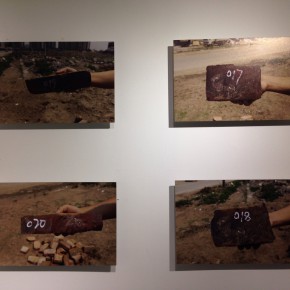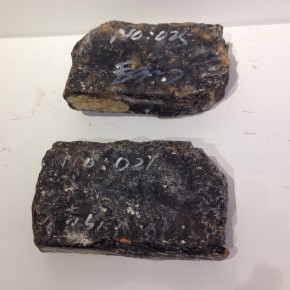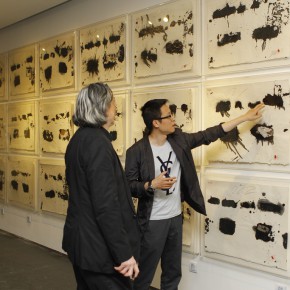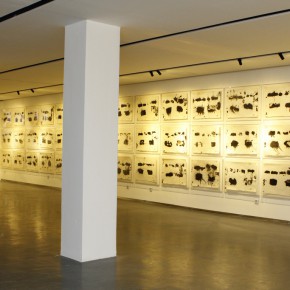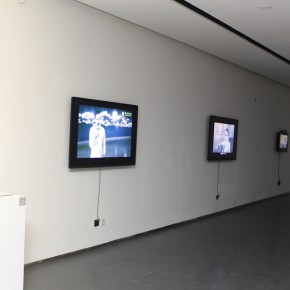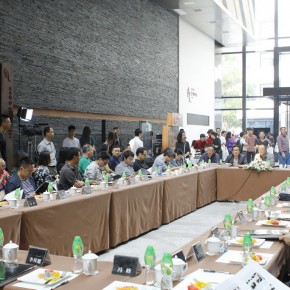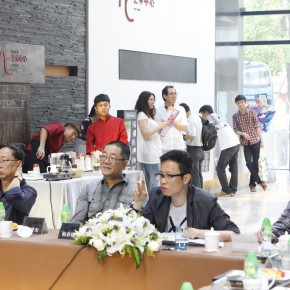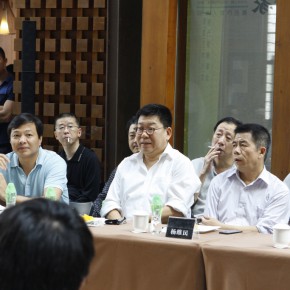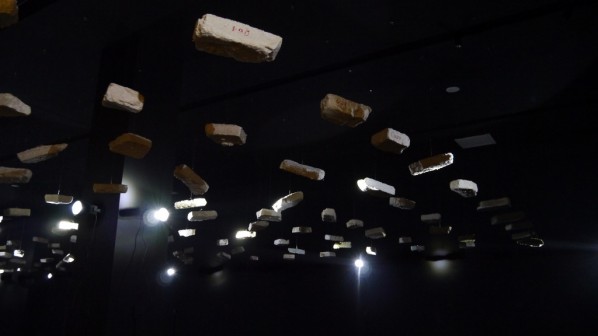
Jointly hosted by CAFA Art Museum and Guangzhou Times Culture Complex Art Center, Wang Huangsheng serving as the art director, planned by Hang Chunxiao, “Ruins: Re-deconstruction of the Mode in Ink by Li Gang” unveiled at the Guangzhou Times Culture Complex Art Center on April 13, 2014, and will continue to May 11.
The exhibition is a new experience since the “Transmit by Copying Chinese Painting and Calligraphy: Li Gang Solo Exhibition” of 2012 which expresses the artist’s new thinking and understanding of contemporary ink art. “Ruins: Re-deconstruction of the Mode in Ink by Li Gang” was held at Shaanxi Province Art Museum on July 10, 2013, while the Guangzhou exhibition is the second show in the solo exhibition project. Different from our familiar abstract ink experimental painting, with a strong sense of form, Li Gang through the exhibition features a brand-new exhibition appearance, covering video, installation, ink painting, performance, concept, etc. It is a bold creative experiment after “removing brush but to perform ink experiment”, where Li Gang “gives up pure rice paper painting”, using the concept of “extracting, absorbing, transferring, changing” to re-deconstruct his creative way in ink painting. The exhibition hall space is divided into four parts according to the artist’s concept of “extracting, taking, transferring, and changing”, presented in four independent spaces.
Firstly, in the section of “extracting”, the exhibition hall is decorated as a site of ruins, and a film recorded the artist’s picking up residual bricks as the scene of the real ruins is played on the wall behind the ruins. Secondly, in the section of “taking”, the numbered original bricks picked up from the ruins, as well as the photos of bricks are on display like vigorous archives, which showcase a strong ritual sense. Thirdly, in the section of “transferring”, the brick rubbings of abstract sense are mounted in the frames, which are at a juxtaposition and on display, so the audience can feel the strong visual impact of the 100 ink works. Fourthly, in the section of “changing”, it uses the original brick molds to produce pulp sculptures and numbers them in accordance with the original bricks, suspended in a dim room at a certain height, the 100 “fake bricks” also have a strong visual tension with the audience. The entire set of work is centered on rubbings, significantly weaving the relationships between ink, rice paper and images.
After the end of a brief opening ceremony, discussion “The Boundary of Ink?” was held at the atrium of the Times Culture Complex Art Center. Wang Huangsheng serves as the academic director, curator Hang Chunxiao served as the commentator. The guests that were present included Wang Lin, Yin Shuangxi, Yin Xiaobin, Lu Hong, Yang Weimin, Wu Hong, Wu Hongliang, Wang Chunchen, Hu Xia, Tang Keyang, Liu Libin, Lu Mingjun, Hu Bin, Cai Meng, Sheng Wei, Fu Zhongwang, Zhang Yangyu, Liu Zijian, Wang Zhong and so on.
It is worth mentioning that around the opening day, Li Gang also operated an interactive project of art performance. Recruiting old architectural bricks from all sectors of society, together with the information tablets of the bricks which are lined up on display in the atrium. In such a continuous interactive project, Li Gang hopes to work together with local people to continue collecting interesting stories, thus the work can constantly grow in an open field. In addition, during the exhibition three children’s activities will be launched on April 20, April 28, and May 4, organizing children to visit the exhibition, meanwhile inspiring them to use the garbage of life and creating.
About “Ruins: Re-deconstruction of the Mode in Ink by Li Gang”
It’s obvious that Li Gang’s ink paintings fail to reflect a visual illusion of the style of ancient architecture. What is a “visual illusion?” When a tourist visits the ruins of ancient architecture, what he/she sees is not the ruins themselves, but a cultural imagination wrapped in a variety of discourse. Thus, the visual appearance is no longer the vision itself, but the cultural landscape of imagination. So does ink painting become an historical relic. It often becomes the object of the nostalgic tour today – the stature of people in front of ink painting is usually controlled by a cultural imagination, making it an imaginary thing like a tourist destination. However, when the ancient ruins depart from the historical background, all the imaginations related to the history are romantic “mirages”, rather than the reality of today. Just like the Summer Palace, except for the seemingly tragic historical landscape, it truly reflects the calmness while the artefacts return to nature. So does ink painting, prevailed on by the related terms of pen and ink, literati, etc., “cultural mirage” become romantic films for viewing, deleting its material quality as an artistic medium, finally becoming a obsolete repertoire.
Li Gang, who had disseminated it was quickly alert, trying to give up the generational mode of “visual illusion” in an abstract manner. With a decade of “nonsense” (a joke by Li Gang’s friend), his folding, rubbing, and transfers are considered an “abstract experience” the original of ink and wash – that’s the promotion of the two aspects including graphics and media, arousing people’s attention. It’s certain that his works get rid of the imaginations in ink through the usual experience, inspiring the self-expression of the ink and wash media with formalism. But since the birth of “abstract ink” in the 1980s, it has been saddled with responsibility – to prove the value of ink painting with the use of artistic logic across the world. If we treat the responsibility as a defaulted attitude, the “abstract ink” naturally has another imagination as being “against historical and cultural imagination” – the “visual illusion” of skyscrapers appeared after the ancient architecture. After abstract ink, experimental ink and performance ink were promoted, trying to get out of the shadow of a “visual illusion”.
Going into the ruins of modern architecture, Li Gang explores the logic of “getting out of it”. Folding, rubbing and transferring, etc were transformed into a specific program about “ruins”, in addition, the exhibition space is constructed using various media including real items, videos, etc, deleting some defaulted definite meanings, to generate a “metaphor” in the symbiotic structure of ink and ruins: As with cultural ruins, ink painting prefers to find the obscured visual effectiveness of the process of getting rid of various “visual illusions”, activating the ideographic space of “ruins” in the reconstruction, to form romantic aesthetic nostalgia.
About the exhibition
Art Director: Wang Huangsheng
Curator: Hang Chunxiao
Duration: April 13 – May 11, 2014
Venue: Culture Complex Art Center (No.33 Huangyuan Road, Baiyun District, Guangzhou City)
Organizers: CAFA Art Museum and Times Culture Complex Art Center
Co-organizer: Times Culture Complex
Acknowledgement: Times Property
Text edited by Zhu Li, translated by Chen Peihua and edited by Sue/CAFA ART INFO.? Part of the photos courtesy of the organizer.?




